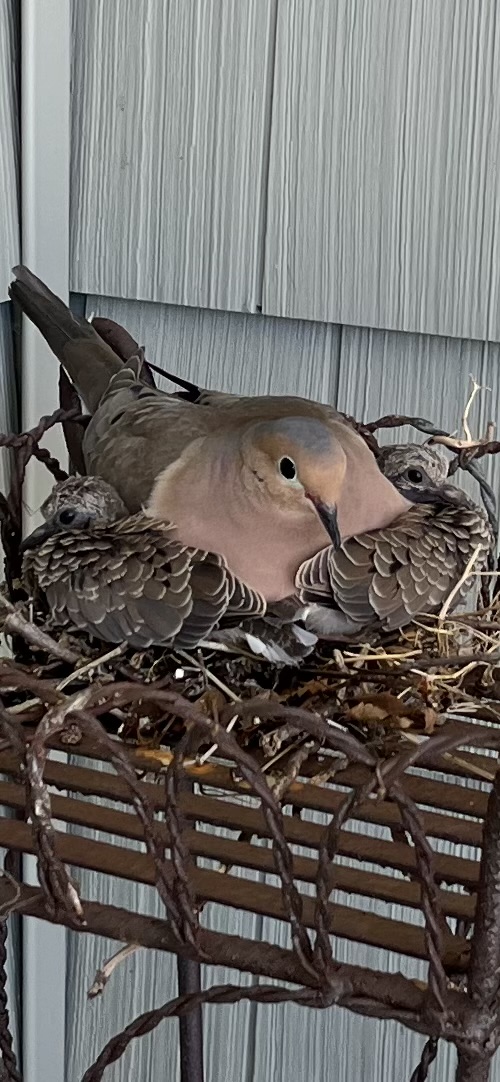
Dove Nest (Vicki and John Hanlon)
By Terry W. Johnson
There are many reasons why the mourning dove is an extraordinary bird. For example, it is the only bird native to the U.S. that breeds in all 50 states. This dove is also one of the country’s most abundant birds (with numbers estimated at 400 million) and is our most popular game bird (hunters harvest more than 20 million each year).
All of this is truly remarkable when you consider that mourning doves build the flimsiest nests imaginable. In addition, this highly successful bird will nest just about anywhere, including on a wide array of manmade objects.
History tells us that when the first European colonists arrived in North America, mourning doves were nowhere near as abundant as they are today. However, as colonists cleared and fragmented what were previously unbroken stretches of forests, and as the population of the New World grew, it became apparent that the changes taking place in the environment were benefitting mourning doves. This was due, in large part, to the fact they prefer to inhabit forest edges, open woodlands and fields. The dramatic shifts in the landscape served the mourning doves well: They are seemingly as abundant in cities and suburbs as they are in rural areas.
Consequently, these birds are now successfully nesting in a wide and sometimes bizarre range of places.
In natural settings, mourning doves typically nest in trees (particularly pines and other evergreens), leafy shrubs and vines. While their nests can be 50 or more feet above the ground, most are built 10-25 feet up. That said, mourning doves will occasionally construct nests on the ground. Some nests have even been found on the top of stumps surrounded by water. The birds will also build their nests on those of other birds – including egrets, American robins, gray catbirds, northern mockingbirds, cardinals, common grackles and barn swallows – and even on the gray squirrel nests. Remarkably, in Michigan, a mourning dove was found brooding two young black-crowned night herons.
Mourning doves usually build their nests in the crotches of tree limbs. The nests are so flat, one cannot help but wonder why the eggs don’t roll out of the nest. It is almost a stretch to say that mourning doves build a nest at all. The nests are so flimsy, unless you see an adult, eggs or young in a nest you probably would not even recognize it. They look like nothing more than a collection of loose sticks. Often the eggs and young can be seen through the underside of the nest!
Females build the nests. The males collect the nesting materials, such as pine needles, small twigs, rootlets and weed stems. They pass them on to their mate while standing on the female’s back. It takes the female only about two days to fashion her makeshift nest.
On an average, mourning doves nest three times a year in Georgia. It is possible to find mourning doves nesting throughout the entire year. However, nesting peaks from May into July.
Nowadays, mourning doves often nest in parks and residential areas across the state. They nest in muscadine arbors, on Christmas tree farms and around government buildings, school campuses, houses and backyards alike. In fact, if your yard has trees and shrubs, there is a chance doves will nest there. About all mourning doves need for a nesting site is a flat surface that offers some degree of protection from predators and the weather.
Years ago, a longtime Monroe County resident called me one evening to report she had found mourning doves nesting on a white column in front of a small rural church, Hopewell United Methodist. Since I had never seen a mourning dove nest on a building, the next day I made a short trip to the church to see. Sure enough, at the far end of the porch was a mourning dove perched atop a nest. While looking at the nest, I realized that this quiet setting was an ideal place for a dove nest.
Since then, I have learned that mourning doves commonly use buildings as nest sites. Some nests are built behind the downspouts on gutters or even in the gutters. Some doves actually build nests inside garages and on top of automatic garage door openers. Doves will even nest on top of window air conditioners, seemingly unperturbed by the noise the units make on hot summer days. The windowsills of bedroom windows provide doves with much quieter places to lay their eggs and raise their young.
When satellite dishes sprang up like mushrooms across the state, doves were quick to nest between the dishes and the poles supporting them.
Doves sometimes place their nests in wreaths hung on doors. Homeowners occasionally find that their flower boxes and hanging baskets contain flowers and, yes, dove nests.
Nests are also built on the back of backboards at outdoor basketball courts and where outdoor light fixtures attach to poles, outbuildings and homes. Nests have been found on the shelves of outdoor grills and atop stepladders learning against buildings.
When mourning doves build their nest close to or literally on our homes, it provides us with fantastic wildlife viewing opportunities that cannot help but heighten our appreciation of this amazing bird.
At a time when the populations of scores of birds are steadily declining, it is refreshing to know that the mourning dove is proving adaptable enough to thrive in our modern world. Their success is a tribute to their adaptability and sound conservation practices employed by state and federal wildlife agencies.
Terry W. Johnson is a retired DNR program manager and executive director of TERN, the Wildlife Conservation Section’s friends group. Check out past columns, his Backyard Wildlife Connection blog and his book “A Journey of Discovery: Monroe County Outdoors.” Permission is required to reprint his columns.




















